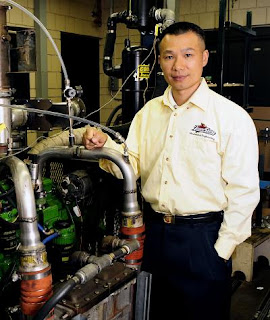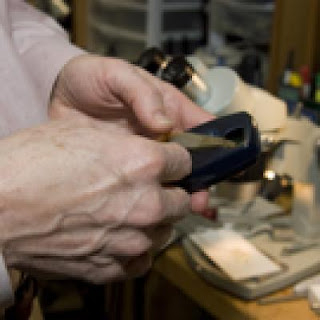TEMPE, Ariz. – Imagine flexible lighting devices manufactured by using printing techniques. Imagine solar power sources equally as reliable and as portable as any conventional power source.
Such advances are among aims of research at Arizona State University to find ways of more effectively harnessing solar power and producing more energy-efficient, durable and custom-designed light sources. The work is now drawing support from two international corporations.
U.S.-based Solterra Renewable Technologies Inc. and Nitto Denko Corp. of Japan are investing more than $3.7 million through grants to help fund the research led by ASU engineering professor Ghassan Jabbour.

Ghassan Jabbour, Professor School of Materials Email: jabbour@asu.edu Phone: (480) 727-7002 | Jabbour's work focuses on the use of nanomaterials and quantum dots in solar cells and solid state lighting. Technical advances in this area "will open the way for a new wave of more efficient and portable power and light sources in as many shapes and varieties as designers can imagine," he says.
Jabbour, who teaches in ASU's School of Materials, is doing his research through the Advanced Photovoltaics Center, which he directs. The center is part of the Arizona Institute for Renewable Energy at ASU. Jabbour also is director of optoelectronics research for the Flexible Display Center, part of the university's Ira A. Fulton School of Engineering. |
Illuminating printing processes
Work funded by the grants will include the study of the materials science, physics and engineering solutions necessary to produce the next generation of solar cells, which will cost less to produce and perform more efficiently, Jabbour says.
The project is an example of the economic benefit a research university can bring to its state. Each year, Arizona universities contribute nearly $1 billion into the Arizona economy from their research, most of which is funded by the U.S. government and entities from outside the state. Research money brought in by universities is restricted money that can be used only for the research activity it supports. It cannot be used to compensate for cuts in other parts of the university's budget.
The quantum dots/solar cells project already has brought a small company to open new operations at the ASU Research Park. Given the increasing interest in solar energy and the means to produce it at lower costs, the company can be expected to grow rapidly, Jabbour says.
One of the major scientific and engineering challenges of Ghassan's project involves how to employ printing techniques to fabricate low-cost alternatives to current solar cells. Research articles on printed organic solar cells written by Jabbour and other members of his team continue to be cited by fellow researchers more than any other articles in the area of printed ultra-thin solar cell research. (Ultra-thin means it involves materials less than 100 times the thickness of a typical human hair.)
Printing is a viable method for mass production of solar cells. Some printing techniques, such as silk-screen printing (commonly used to print logos, numbers and pictures on textiles), are already used in some aspects of solar cell manufacturing.
Printing allows for large numbers of solar-cell devices to be manufactured rapidly, thus eventually bringing down costs.
"In our work, we will be investigating various techniques such as inkjet printing, screen printing, and roll-to-roll, which is similar to newspaper printing techniques, to see what works best for solar cell manufacturing," Jabbour says.
The power of photons
The material science and engineering aspect of the projects involves experiments with materials that exhibit unique properties at the nanoscale, specifically materials that use photons to achieve more efficient conversion of energy into electricity. The materials also have a broader absorption spectrum of incident solar light – meaning they can make more effective use of solar light for conversion into electricity.
"It's traditional to generate one electron-hole pair for every absorbed photon in most solar cells," Jabbour says, but researchers in his lab are working on generating more multiple electron-hole pairs per photon to achieve increased power-conversion efficiency. This is accomplished by producing a higher number of electrons for each absorbed photon from incident light.
In most bulk semiconducting materials, Jabbour explains, absorption of an incident photon (light quanta) with the right energy can excite an electron enough to move it across an energy band gap – thus resulting in an electron-hole pair. But the same photon might generate more than one electron-hole pair if the material is made into much smaller dimensions – such as the size of a quantum dot.
Quantum dots are small particles about few nanometers (a billionth of a meter) in size. By adjusting the particles' physical dimensions, their optical and electronic properties can be fine-tuned. Through such a process, the resulting characteristics of the materials are different than the characteristics of the same material in bulk size, Jabbour explains.
The challenge is how to extract most of the charges from the dots to transfer in the form of electrical current to the device being powered by the solar cell, he says.
Recent results of 3 percent in power conversion in this area are encouraging. Such an efficiency will continue to climb as better materials and device structures are being developed, which is a part of Jabbour's work supported by the grants.
Energy conservation goals
More efficient solar cells are only one part of the solution to the nation's growing energy needs. Just as important is making efficient use of energy in conventional systems, Jabbour says.
The two technologies he and his team are working on are interrelated, involving both energy generation and energy conservation. Although there is a strong push for alternative energy, including solar energy, Jabbour says much can be accomplished by focusing on research to lower the power consumption of conventional technologies. This work involves the area of solid state lighting.
One of the corporate grants is supporting work directly aimed at understanding the materials and device physics of nanoscale structures for low-power, nanothick solid state lighting applications.
The materials used are hybrid nanomaterials targeting white-light emission from a single building block. The light source made out of these materials also will have a nano-range thickness and can be operated at high brightness (equivalent to a ceiling lamp) using a 9-volt battery source. Just as with solar cells, these light sources will also be printable in the future, Jabbour says.
Flexibility in lighting devices
"The beauty of these two projects is their compatibility with rugged substrates, including flexible ones," he says.
A substrate is a material on which circuits or other small devices are formed or fabricated. Flexible substrates (for example, plastic, thin metal foils, or cloth) allow for more durable lights that also weigh less than conventional lighting devices and can be produced in a variety of shapes.
"Imagine a light that is made on a roll that can be cut into various shapes according to the desire of the user," Jabbour says. Such an advance is still far off, but not impossible. In fact, he points out, printed lights made out of inorganic phosphors that operate at about 120 to 150 volts are already available. The drawback is that currently they can be operated only at such high voltages.
The two technologies promise to provide low-cost, high-efficiency solar cells and solid state lights that can be made on thin flexible substrates, resulting in light-weight durable modules that are easier to place on roof tops (for example, solar-cell arrays) and indoors (lamps and similar lighting devices). ###
- SOURCE: Ghassan Jabbour, jabbour@asu.edu Professor, School of Materials. Director, Advanced Photovoltaics Center (480)727-8930
- MEDIA CONTACT: Joe Kullman, joe.kullman@asu.edu (480) 965-8122 direct line (480) 773-1364 mobile
- Ira A. Fulton School of Engineering. Arizona State University. Tempe, Arizona USA. www.fulton.asu.edu/fulton/
Contact: Joe Kullman,
joe.kullman@asu.edu 480-965-8122.
Arizona State University


































